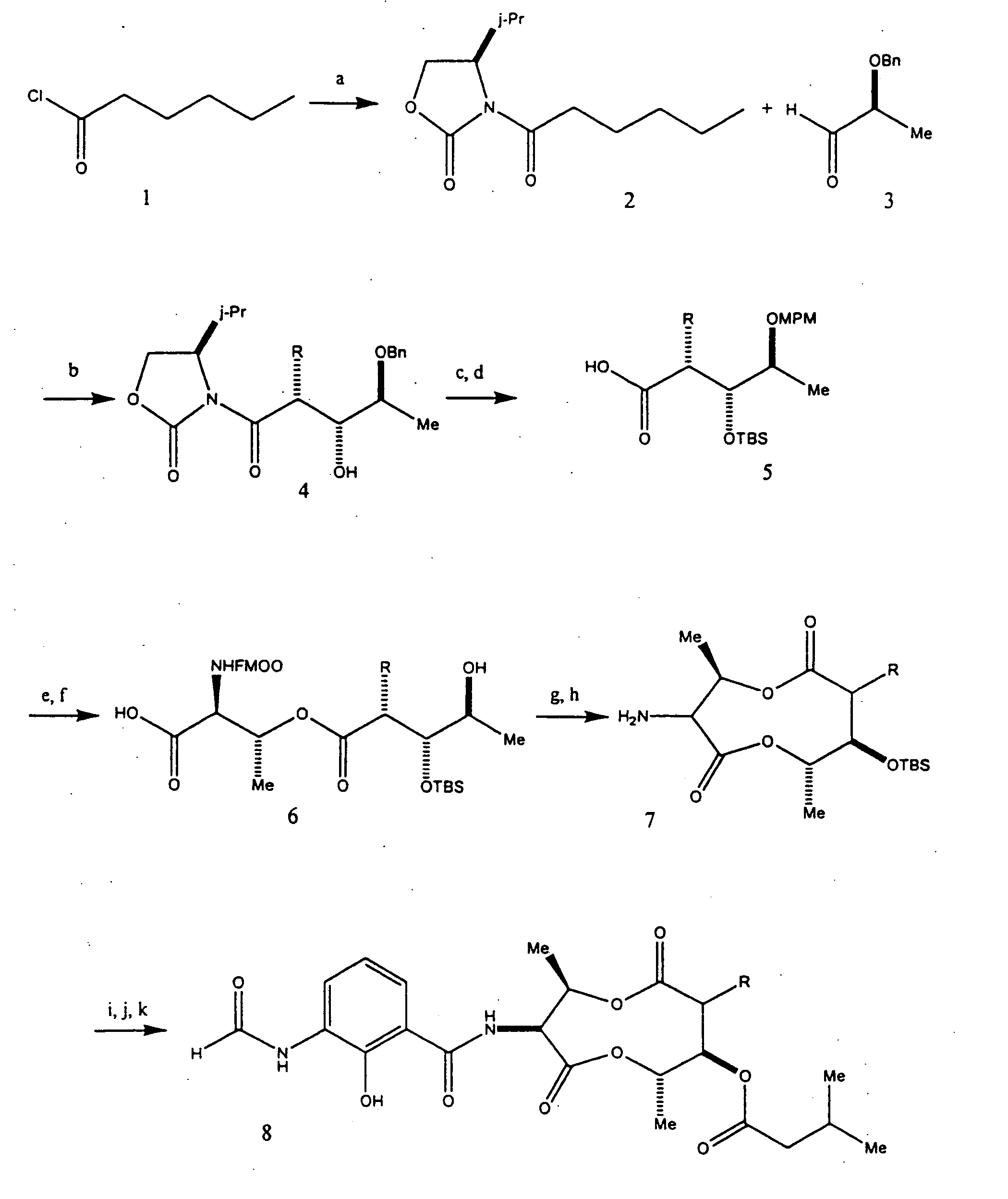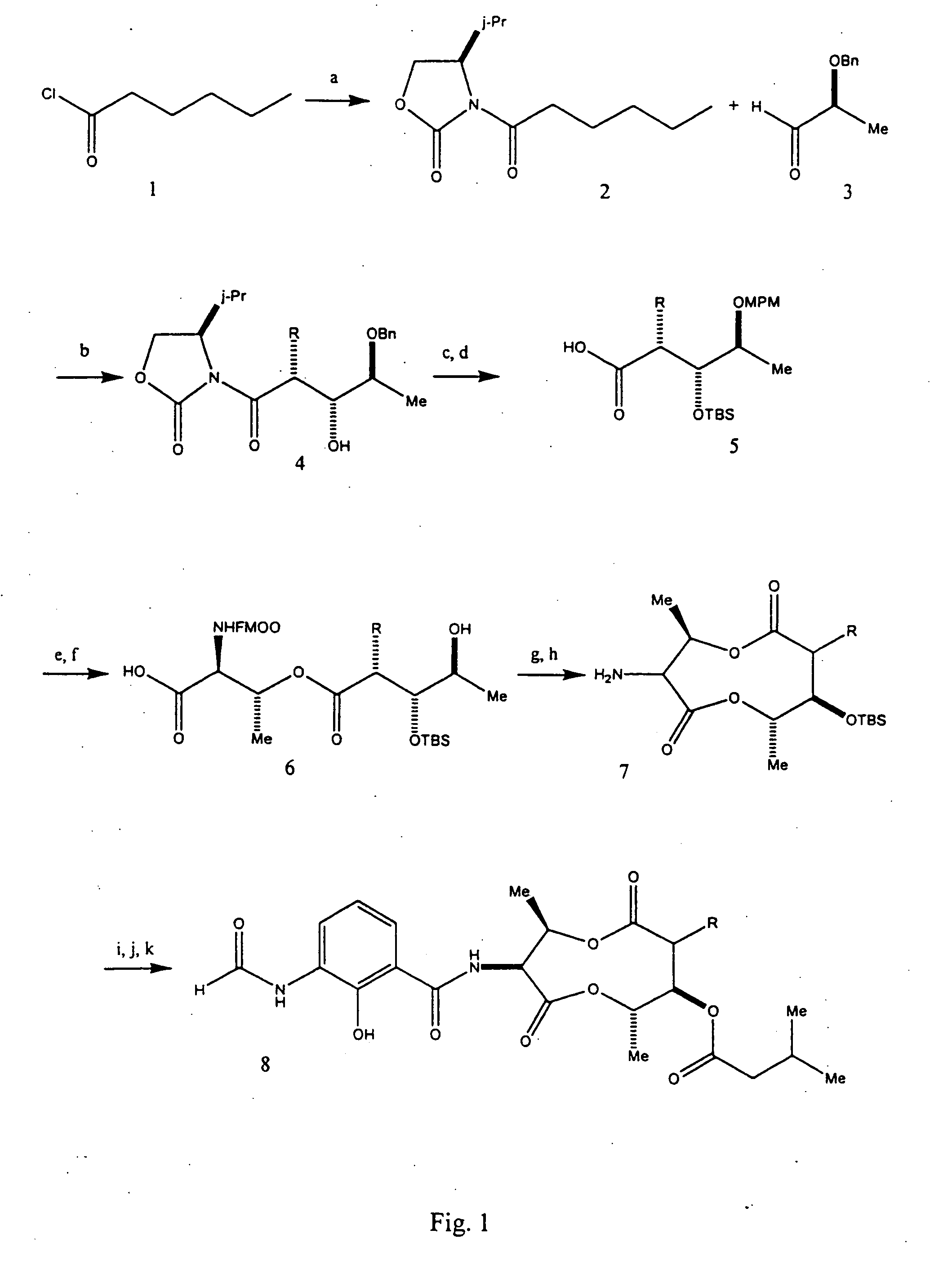2 Methoxy antimycin a derivatives and methods of use
a technology of methoxy antimycin and derivatives, which is applied in the field of methoxy antimycin a derivatives and methods of use, can solve the problems of reducing the ability of certain antimycin a derivatives to bind to and inhibit cytochrome, and toxic natural-origin antimycins, so as to inhibit the activity of an anti-apoptotic, inhibit the activity of the anti-apoptotic, and reduce the binding
- Summary
- Abstract
- Description
- Claims
- Application Information
AI Technical Summary
Benefits of technology
Problems solved by technology
Method used
Image
Examples
example 1
[0103] To examine the sensitivity of cells over-expressing BCl-xL to various mitochondrial inhibitors and apoptosis inducers, cell lines over-expressing Bcl-xL were prepared and tested.
[0104] Briefly, a DNA fragment encoding the full-length mouse BCl-xL cDNA was isolated from the plasmid PBS.BCL-xL (Tzung et al., Am. J. Path. 150:1985-1995, 1997, incorporated herein by reference in its entirety) by digestion with the restriction endonuclease EcoRI. This EcoRI fragment was cloned into the EcoRI site of the mammalian expression vector pSFFV (Fuhlbrigge et al., Proc. Nat. Acad. Sci. USA 85:5649-5653, 1988) in both sense and antisense orientations, to form expression plasmids pSFFV.Bcl-xL(sense) or pSFFV.Bcl-xL(antisense), respectively. The tumorigenic murine hepatocyte cell line TAMH was transfected by lipofection (Lipofectamine, Life Technologies, Rockville, Md., according to the manufacturer's recommendations) with the plasmids pSFFV.neo (the control), pSFFV.Bcl-xL(sense) or pSFFV.B...
example 2
[0114] In this example, various biochemical and biophysical indices associated with antimycin A treatment were examined and correlated with cell death. Specifically, reactive oxygen species (“ROS”) and ATP production were examined soon after initiating antimycin A treatment. Other parameters of mitochondrial function were also measured.
[0115] Electrons as reducing equivalents are fed into the mitochondrial electron transfer chain at the level of Coenzyme Q (CoQ) from the primary NAD+—and FAD-linked dehydrogenase reaction and are transferred sequentially through the cytochrome chain to molecular oxygen. As discussed above, antimycin A inhibits complex III (CoQH2-cytochrome c reductase) downstream of CoQ. Complex III serves as an electron transfer station for transfer of electrons from CoQ to cytochrome c. Because CoQ is the major source of ROS derived from the mitochondrial respiratory chain (Turrens et al., Arch. Biochem. Biophys. 237:408-414, 1985), inhibition of complex III often...
example 3
[0130] This example demonstrates that antimycin A-induced cell death is caspase independent. Bcl-2-like proteins can suppress apoptosis through direct and indirect effects on the cytosolic caspase-activating apoptosome complex (caspase-9, APAF-1 and cytochrome c) or by maintaining mitochondrial membrane integrity and osmotic homeostasis (Cosulich et al., Curr Biol. 9:147-150, 1999). Thus, antimycin A could initiate apoptosis in Bcl-xL-over-expressing cells by inducing BCl-xL to promote, rather than oppose caspase activation, possibly by altering interactions with APAF-1 (Pan et al., J. Biol. Chem. 273:5841-5845, 1998; Hu et al., Proc Nat. Acad. Sci USA. 95:4386-4391, 1998).
[0131] TABX2S and TABX1A cells were exposed to the broad spectrum caspase inhibitor, benzyloxycarbonyl-Val-Ala-Asp-fluoromethyl ketone (zVAD-fmk). Antimycin A-induced death of TABX2S cells was found to be caspase-independent, as shown by the inability of zVAD-fmk to rescue such cells from cell death. This result ...
PUM
| Property | Measurement | Unit |
|---|---|---|
| Fraction | aaaaa | aaaaa |
| Structure | aaaaa | aaaaa |
| Pharmaceutically acceptable | aaaaa | aaaaa |
Abstract
Description
Claims
Application Information
 Login to View More
Login to View More - R&D
- Intellectual Property
- Life Sciences
- Materials
- Tech Scout
- Unparalleled Data Quality
- Higher Quality Content
- 60% Fewer Hallucinations
Browse by: Latest US Patents, China's latest patents, Technical Efficacy Thesaurus, Application Domain, Technology Topic, Popular Technical Reports.
© 2025 PatSnap. All rights reserved.Legal|Privacy policy|Modern Slavery Act Transparency Statement|Sitemap|About US| Contact US: help@patsnap.com



